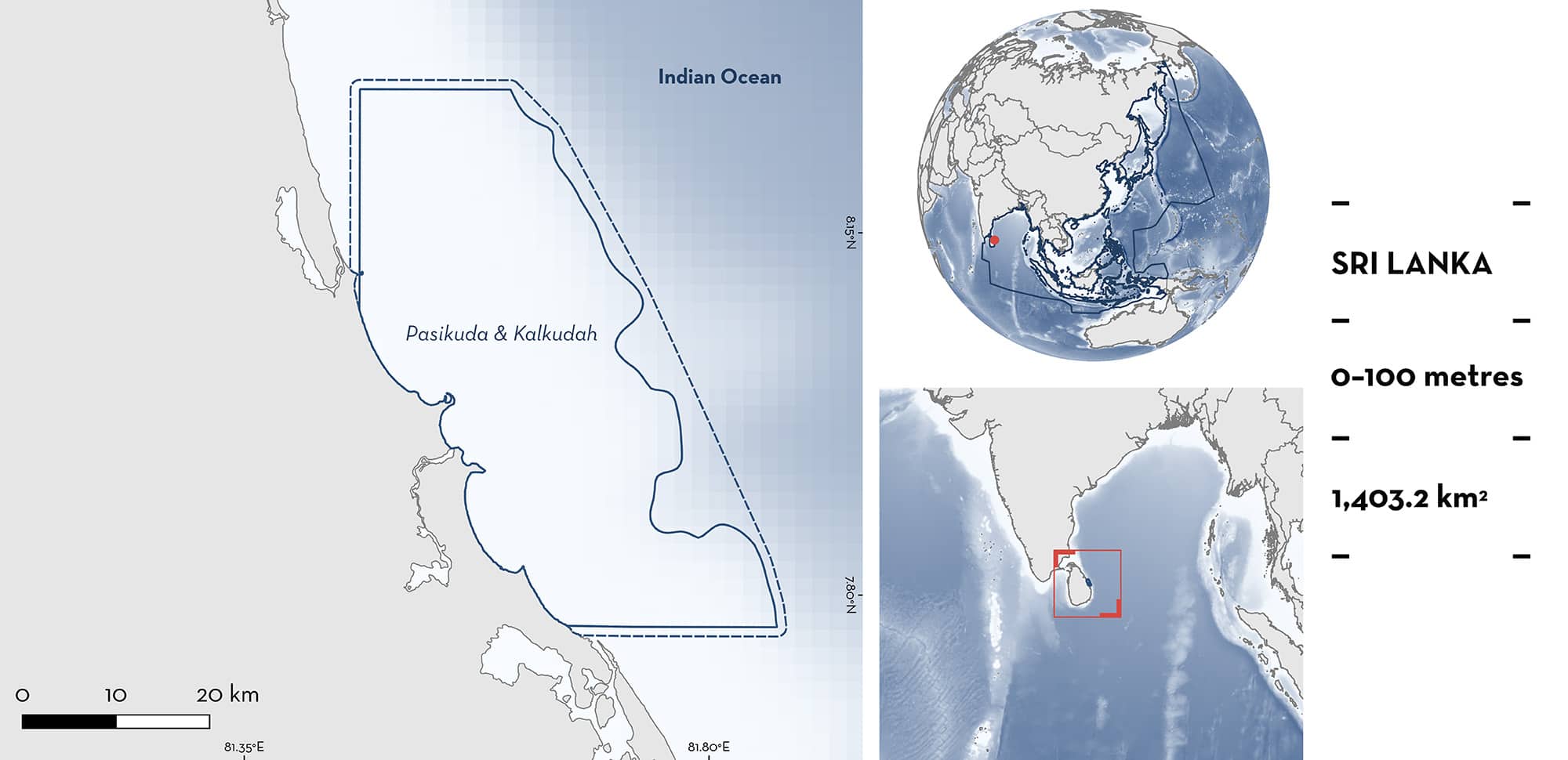ISRA FACTSHEETS
ISRA FACTSHEETS
ASIA REGION
Pasikuda & Kalkudah
Summary
Pasikuda & Kalkudah is located in the Batticaloa district on the eastern coast of Sri Lanka. The area is characterised by mangroves, sandy substrates, and coral reefs and outcrops. It is influenced by a large perennial stream, the Maduru Oya, that drains into the area from the Valaichchenai Lagoon. The area encompasses the Kayankerni Marine Sanctuary. Within this area there are: threatened species and range-restricted species (Stripenose Guitarfish Acroteriobatus variegatus).
Download factsheet
Pasikuda & Kalkudah
DESCRIPTION OF HABITAT
Pasikuda & Kalkudah is located in the Batticaloa district on the eastern coast of Sri Lanka. The area is primarily a shallow coastal shelf site including two bays of <50 m depth and deeper offshore waters. A large perennial stream, the Maduru Oya, drains into the area from the Valaichchenai Lagoon (Silva et al. 2013). The area is characterised by large areas of remnant mangrove vegetation along the coastline. Relatively undisturbed mangroves and lagoon habitats are found within the Elephant Point headland which sits within the area (Blue Resources Trust unpubl. data 2024).
The Kayankerni coral reef, part of the Kayankerni Marine Sanctuary, is a nearshore reef that extends from Vaharai in the north to Kalkudah in the south. It has a depth of 5–8 m with the shallowest areas being exposed at low tide. The fringing reef lagoon and nearshore areas consist of isolated coral colonies, coral rock, algal mats, and seagrass meadows. Further offshore, isolated reefs and outcrops can be found at depths of 10–15 m (Perera 2019). Isolated fringing reefs are known to occur in parts of Kalkudah Bay, and the rest of the area is primarily composed of sandy substrates with isolated boulders and soft coral.
The area encompasses the Kayankerni Marine Sanctuary (Perera 2019).
This Important Shark and Ray Area is benthopelagic and is delineated from inshore and surface waters (0 m) to 100 m based on the bathymetry of the area.
CRITERION A
VULNERABILITY
One Qualifying Species within the area is considered threatened with extinction according to the IUCN Red List of Threatened Species. Stripenose Guitarfish is assessed as Critically Endangered (Kyne et al. 2017).
CRITERION C
SUB-CRITERION C1 – REPRODUCTIVE AREAS
This area holds the regular presence of Stripenose Guitarfish as a resident range-restricted species. This species has been regularly documented in fisheries surveys conducted between July 2019 and December 2023 at a landing site associated with fisheries operating in the area. Pethalai landing site has an unusually high landing frequency of Stripenose Guitarfish compared to the 20 other landing sites that the species has been observed at (from 87 landing sites surveyed across Sri Lanka; Blue Resources Trust unpubl. data 2024). While the species is landed throughout the year at Pethalai, comparatively higher catches have been recorded between May and September consistently across 2019–2023. This species occurs in the Arabian Sea Large Marine Ecosystem (LME) and marginally into the Bay of Bengal LME.
Download factsheet
SUBMIT A REQUEST
ISRA SPATIAL LAYER REQUEST
To make a request to download the ISRA Layer in either a GIS compatible Shapefile (.shp) or Google Earth compatible Keyhole Markup Language Zipped file (.kmz) please complete the following form. We will review your request and send the download details to you. We will endeavor to send you the requested files as soon as we can. However, please note that this is not an automated process, and before requests are responded to, they undergo internal review and authorization. As such, requests normally take 5–10 working days to process.
Should you have questions about the data or process, please do not hesitate to contact us.


